OVERLAP FLANK PROTECTION RAILWAY SIGNALLING
OVERLAP
The distance beyond a stop signal which must be clear and where necessary locked in order to clear previous signal.
Background
The purpose of an overlap is to provide an unobstructed portion of line beyond the exit signal reserved in case the train passes the exit signal at danger. This allows for a misjudgement by the driver or an unanticipated inadequacy of the braking system. With the introduction of TPWS and changes in driving practice, the likelihood of a signal being passed at danger has reduced and the distance trains are likely to travel into the overlap has reduced.
The layout designer may in conjunction with the layout risk assessor, define a number of different types of overlap. The following sections summarise those in common use.
Full overlap
An overlap which is appropriate for all speeds of approach and is at least 180m long is called as Full Overlap.
Reduced Overlap
An overlap that is shorter than the minimum permitted length of a full overlap, where the permitted approach speed is below a specified level which still allows an unrestricted approach to a signal at danger( i.e. approach control is not necessary).
Reduced Overlap Lengths for Colour Light Signals in TCB Areas
Restricted Overlap
An overlap less than the length acceptable for an unrestricted approach subject to a minimum of 45m. A restricted approach (warning class route) shall be provided where the entrance signal shall be cleared from red when the train has been proven to be slowing down (by use of a TPWS OSS loop or timed track occupancy) or nearly at a stand.
An overlap that is shorter than the minimum permitted length of a full overlap, which is available only when the preceding signal is subject to approach control by selection of a warning class route.
NOTE : It is possible for a restricted overlap to be provided without a corresponding full or reduced overlap where all trains have a restricted approach (unless the forward route is set).
NOTE :Where a full or reduced overlap also exists, then it is permissible for the route to step up when the forward route is set, however the full/reduced overlap shall remain locked even if the forward route is subsequently cancelled.
Phantom Overlap
Where there is not a convenient train detection boundary at the correct position for an overlap, then it is permissible for the overlap to be mid way through a train detection section. This is normally used to avoid a set of points or level crossing being within the overlap and requiring locking or special controls.
It is acceptable for a phantom overlap to be at the clearance point of a set of trailing points and for the train detection to be eliminated from the overlap where the points are not aligned for the overlap.
Phantom Restricted Overlap
It is also permissible to define a restricted phantom overlap where there is not a train detection boundary before a set of trailing points. The conditions for proving of train detection are the same as for a phantom overlap.
Shunt Overlap
An overlap of minimum 50m provided for a shunt class route where another overlap (e.g. full) does not exist or where the use of that overlap would be unduly restrictive.
Overlap Locking
When a route is set requiring an overlap, the overlap shall be locked in a similar way to the route such that an exclusive overrun is maintained. Where the overlap includes facing points then the overlap locking shall follow the lie of the facing points.
Flank Point Protection
Provision of Flank Point Protection
1 Flank point protection shall usually be provided to protect the route and overlap for a signalled train movement. Point c4 is a flank point should be locked to normal ,to clear signal C1 for main line movement.
2 Subject to risk assessment, it is permissible to waive the requirement to flank point protection where:
- a) permissible traffic movements would be unreasonably restricted; or
- b) a net reduction in risk would not be achieved; or
- c) the flank points are not free to be set to the protecting position at the time that
the route is being set (eg because a signalled movement is in progress away from the area of conflict via the points in their non-protecting position).
3 Flank points shall usually be set at the time that the route requiring protection is set but, in the case of (c), it is permissible for the flank points subsequently to be Provide moved to the protecting position when they become free.
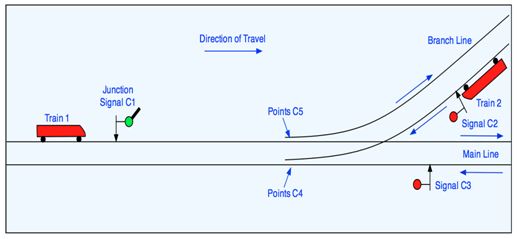
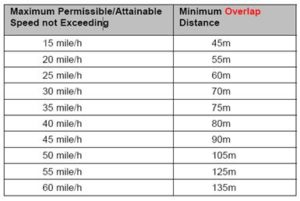
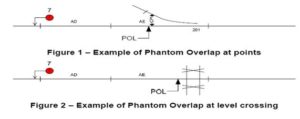
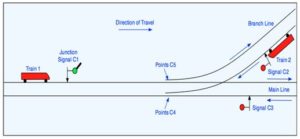
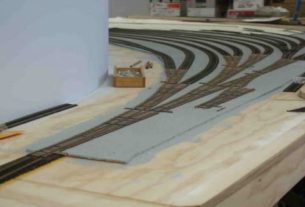
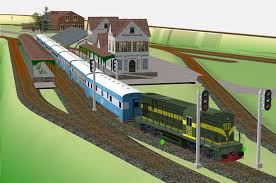
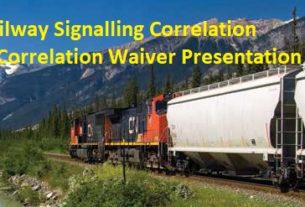
Kindly requested to furnish me with your scope of work.